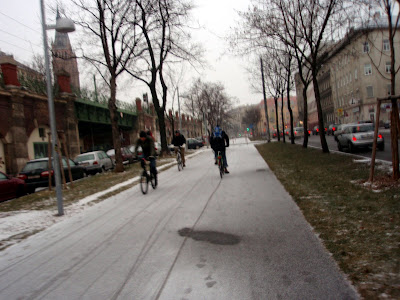 Today was a lovely morning - snowing, a little bit of snow on the road and not too cold. I enjoy riding in this weather, cause it wakes me up and I get nice red cheeks.
Today was a lovely morning - snowing, a little bit of snow on the road and not too cold. I enjoy riding in this weather, cause it wakes me up and I get nice red cheeks.But then it happened. When I wanted to cycle home in the evening I discovered my flat rear tire. Again. (That just happened a few weeks ago.) Most likely it was caused by grit (crushed stone they put on the road here in the winter for more grip - but also for more flat tires). Maybe I should have learned something from the last time. Last time I had to walk my bike 3km home, because I didn't have my repair kit with me. But on the other hand, that was my first flat tire in years. I don't want to carry around my repair kit all the time if I only have a flat tire every ten years or so. And to be honest I also wouldn't want to carry it around if I had a flat tire every month.. But well, that's why I had to leave my bike at the bike rack and had to use public transport. I hate public transport, especially in the winter. I have to wait in the cold for ages, it's crowded and it takes forever (well, at least twice as long as with the bicycle). And I need to walk a lot. I was tired and I didn't want to walk.. Hm, I had to anyway. Tomorrow morning I will have to take the tram again and therefore have to get up 30min earlier. But I will take the repair kit with me and fix my bike as soon as I get there ;-).
Photos: 1 lady in red at the subway station with a stylish blue Ortlieb bicycle bag (they are waterproof!), 2 some people cover their bike seat with a plastic bag if they have to leave it outside (quite practical), 3 traffic on a usual winter morning.







